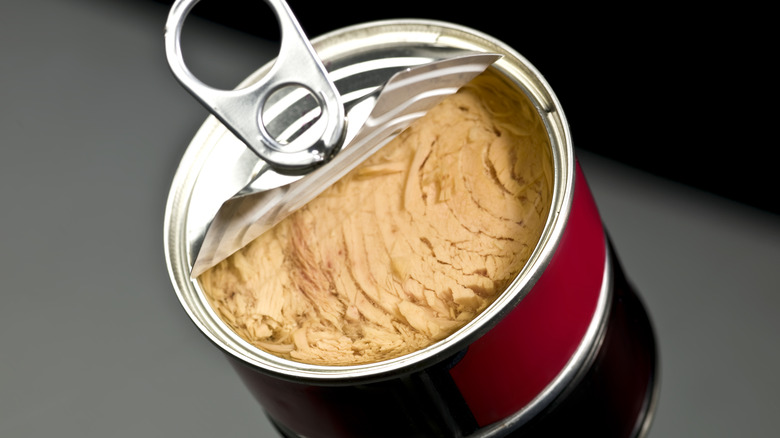Why Is Canned Tuna Always Sold In Such Small Containers?
Come the holiday season, there are certain staple ingredients that we look to stock our kitchen with. Tuna, a versatile ingredient in wholesome tuna sandwiches and delicious and healthy tuna salad, is undoubtedly one of them. Its easygoing flavor can do well even when combined with unexpected ingredients. Yet there is a bugbear that many of us have with cans of tuna — the fact that they are tiny. When you are cooking a tuna dish for a large group of people, you may need to open multiple tiny cans and deal with a larger and more annoying mess.
Have you ever wondered why canned tuna is always sold in such small containers? Wouldn't it be better to have the option of buying larger containers, should you choose to do so? The answer is that we don't know for sure. Part of it may be to reduce waste, as leftover canned tuna will only last a couple of days in the fridge. Larger containers, though rare, are indeed available in certain stores. The particular dimensions of tuna cans could also be based on optimization in calculus — or simply tradition. Most nefariously, the tiny cans may be a way of ripping off consumers. Come with us as we investigate the matter further.
What is the rationale behind the small containers for canned tuna?
In response to a query put out on this very question in The Guardian UK, reader SnowyJohn shared a probable reason for the diminutive size of tuna cans. They first said that tuna cans do come in large sizes, but they aren't seen much, and then shared, "I suspect the reason [big cans aren't] more readily available is that people are used to it being in the size of can you normally get it in and it's a popular size as a result. There's not enough demand for many shops to offer alternatives. Same as why soft drinks normally come in 33cl cans or 2l bottles. They just do, and few people question it or ask for an alternative"
Interestingly, a Reddit thread discussed the probable reasons for the wide, short dimensions of tuna cans in comparison to other canned foods. The original poster suggested there was a mathematical reason given by their calculus professor, but they didn't explain further. Other Redditors, however, did not seem on board with this reasoning, offering other potential explanations like "marketing as wider cans have more space for advertising" or that the cans fit the machinery in fish canneries better.
Were tuna containers always this small?
You may be wondering if canned tuna containers were always this small. The answer is no. An archived news report from the Seattle Times dating back to 1990 shows the first record of when tuna cans were reduced in size from the normal serving of 6 1/2 ounces to 6 1/8 ounces, ostensibly because some customers had complained about Starkist brand tuna being "more liquidy" than competitors.
Economists and consumer affairs lawyers have observed the trajectory of the reduction in the size of tuna cans over the years, which they attribute to a concept known as "shrinkflation." This means the sizes of goods are reduced by brands, even though the prices of the products remain the same, and in some cases, even increase. The most recent example of the latter was in 2017, when 6-ounce cans of tuna were reduced to 5 ounces with a simultaneous price increase. Cost-cutting due to rising prices or the unavailability of raw materials seems to be at the heart of these business decisions.


